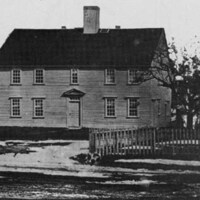First settlers
Item
- Title
- First settlers
- Description
- "The town of Wakefield was first incorporated in 1644, but her first settlers began to arrive from Lynn in 1639. During this time, the settlers began to cross the rough terrain and settle in the area which is now Wakefield after having petitioned the Colony Court to do so. In 1644 after a sufficient number of homes were established, the Court ordered that 'Lynn Village' take the name of 'Redding', presumably after Reading, England from where several of the first settlers emigrated. The town, when incorporated, contained the area of what is now Wakefield and Reading. The area which is now North Reading was added by a land grant in 1651. According to town records the first settlers included 29 men and their families: Nicholas Brown (who settled on the east side of the 'Great Pond' where the Beebe estate now stands), Thomas Clark, John Damon (who settled where the Common now stands), William Cowdrey, George Davis, Robert Dunton, Samuel Dunton, Josiah Dustin, Jonas Eaton, William Eaton, Zackery Fitch, Isaac Hart, Thomas Hartshorn, William Hooper, Thomas Kendall, John Laukin, Thomas Marshall, William Martin, John Pearson, John Poole (who settled where the rattan factory once stood), Thomas Parker, Francis Smith, John Smith, Jeremy Swayne, Thomas Taylor, Edward Taylor, Richard Walker, and John Wiley. The majority of the men were middle-aged when they settled in the town. William Cowdrey (1602-1687), a lawyer and the best educated of the settlers was undoubtedly the most politically and socially active of the first settlers. He had a major role in shaping the early policies, rules and regulations, having served as Clerk of Writs, Deacon of the Church, Alcoholic Commissioners, Town Clerk, Selectman, Representative to the General Court and Justice of the Peace. He served as Town Clerk from 1644 to 1687 and although he was feeble during the last six years of his life, the townspeople refused to fill his position. They chose instead to appoint his son Nathaniel as Town Clerk 'pro tempore' until his father's death. They subsequently named Nathaniel to the position which he held for one year. John Poole was the wealthiest of the settlers, running both the corn and the saw mills in the town. The town granted him land on what is now Water Street for the corn mill in 1644 at the site which was later the rattan factory. He built the saw mill on Vernon Street at the Lynnfield-Wakefield line in 1650. Although prominent in the town, he never held public office and was never a member of the Church. Captain Richard Walker was the Captain of the first training band to help protect the settlers against the Indians. He was officially assigned the task in 1645 after the Court ordered that a military guard should be kept in every town against a surprise attack by the Indians, yet he was training the men in 1644 on his own. Every youth between the ages of 10 to 16 was ordered to 'be trained by an officer of each company on muster days in the use of small guns, half pikes and bows and arrows, lest the Colony should be destitute of powder.' It is written that Captain Walker was honored for his bravery during the Indian Wars. After 25 years he noved on to Nova Scotia where he developed a fur trade and was named Deputy Governor of the Province. Deacon Zachery Fitch (for which Fitch Court was named) was one of the first settlers to build a home in the town on what is now Salem Street at Fitch Court. He was also one of the oldest of the men, settling in Reading at the age of 51. He served as Selectman in 1649, 1651 and 1661." -- Text from calendar by Jayne M. D'Onofrio.
- Image from the Wakefield Municipal Gas and Light Department annual calendar, 1989
- Photo courtesy of the Payro family and Louis Picardi.
- Contributor
- Institution: Lucius Beebe Memorial Library
- Wakefield Municipal Gas & Light Department (Wakefield, Mass.)
- D'Onofrio, Jayne M.
- Coverage
- Massachusetts--Middlesex (county)--Wakefield
- Format
- image/jpeg
- Publisher
- [Wakefield, Mass.] : Wakefield Municipal Gas & Light Department
- Subject
- Dwellings
- Architecture, Domestic
- Type
- still image
- Photographs
- Original Format
- 1 picture : b&w
- Extent
- 9 x 18 cm.
- Media
 mld89_insidefront2.jpg
mld89_insidefront2.jpg
